I hope my parents can look down from the heavens this week with pride. Like all parents, they just wanted their children to be happy, but more than that, for them to get along. Maybe not as best friends, but at least cherish their company and care for each other’s well being. But this isn’t always easy in practice. Todd had the marching orders, whether desired or not, to break the trail, and through sheer luck of birth order I was allowed the time to observe his experiences, learn and adjust. In sailor speak, he was the first into an unknown harbor at night. I got to breeze into the same harbor with all the knowledge and confidence of a seasoned captain. Our divergent roles, and a 4 year age gap, didn’t help. But time is the greatest healer. And learning how to be adequate parents ourselves brought us further together. It was in this spirit that we found a week in our busy schedules to sail together in Croatia. Todd was joined by his wife Molly, and sons Richard and Peter. Unfortunately, their daughter Julia was halfway around the globe in New Zealand pursuing her own geographic adventures and couldn’t make this trip.
My arrangement with Todd was that we would set out for a week in Croatia – renowned for its sailing beauty – but with the caveat that we were completely new to this area and would be learning as we go. For the last in the birth order to be in a leadership position – first in the harbor so-to-speak – was unfamiliar territory to me. Luckily, bountiful sunshine and warm azure waters were in our favor.
After catching up with laundry and filling up the big and little boats with fuel, we set out from the ACI Dubrovnik marina, and within minutes had our first man-over-board drill. OK, it wasn’t a ‘man’ but it was the spray nozzle of our anchor wash down hose, and to my amazement, it actually floated for long enough for us to recover it at the stern. First emergency dealt with. We were now invincible!
The heat of the summer was clearly settling in for the long haul, and we selected a manageable sail up the Elafiti Islands, stopping at Lopud for lunch and then moving on to Luka Sipanska. With so much to see in the myriad of offshore islands that comprise the Croatian coast, we found that fitting in a lunch stop before our overnight destination allowed us to check off more interesting sites on the list.
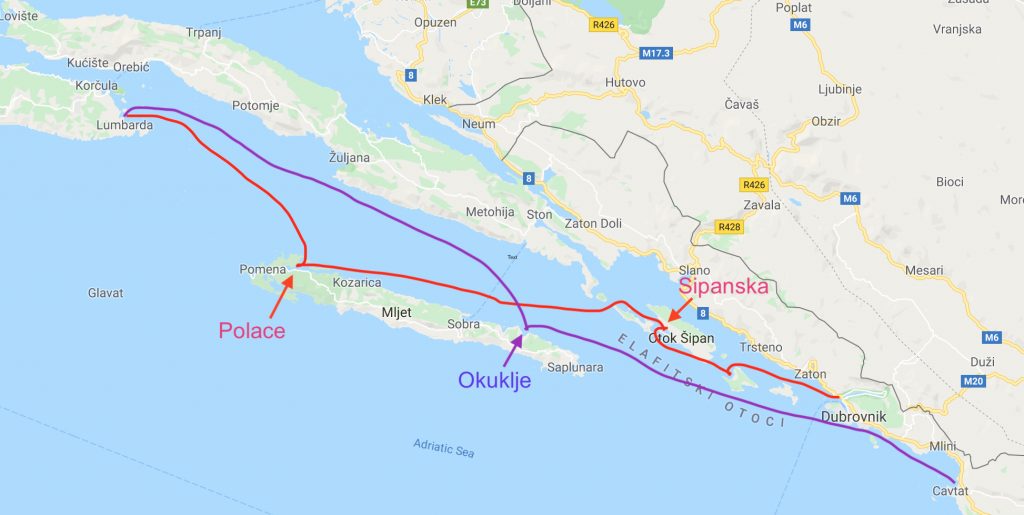
Sipanska was an ideally oriented horseshoe bay facing north, giving us protection from the increasing winds out of the south forecasted later in the evening. With a long entrance, we had our pick of spots to anchor, but by late afternoon, a steady influx of other sailboats rapidly filled up the harbor, with each new arrival trying to cut the spacing in half between existing boats. This can only work for so long but some captains still insist on defying the laws of physics, as one charter boat did next to us – a large crewed catamaran driving in and dropping their anchor with a nonchalant attitude, casually offering their guests accoutrements as they lounged on the forward deck. This wasn’t going to work for me, and I stopped by with the dinghy to check how much anchor line they had out. The exact number escapes me now but it was at least half of what we had out and barely a 2:1 ratio. This started our indoctrination into the paid captain culture in Croatia. Attending to your guests was priority one, regardless if this jeopardized the safety of boats around you. There was a face-saving factor involved in this too. No paid crew wanted to hear from another boat that they had made a poor nautical decision, but especially not overheard by their guests from which they were working hard for an end-of-week tip. So going forward, when we could, we approached paid crew out of ear shot of their guests.
In the end, no high winds swung our boats against each other, and instead, we enjoyed a beautiful walk through the little seaside village and the foothills and orchards of the hinterlands. Someone had put in some forethought and built a paved walkway all the way around the perimeter of the harbor, perfect for walking, running and fishing, and of course a few scooter drivers practicing their slalom turns around pedestrians. We finally had our first bonafide swim off the boat, and paddle boarding around the harbor, as we relished in the turn of seasons. With a little help from Mother Nature we were able to put aside the antics of our fellow boaters, as we enjoyed, in the gathering dusk, the distant silhouettes of coastal mountain ranges flush with deep pinks and purples from the last vestiges of a setting sun. Croatia, you tease!
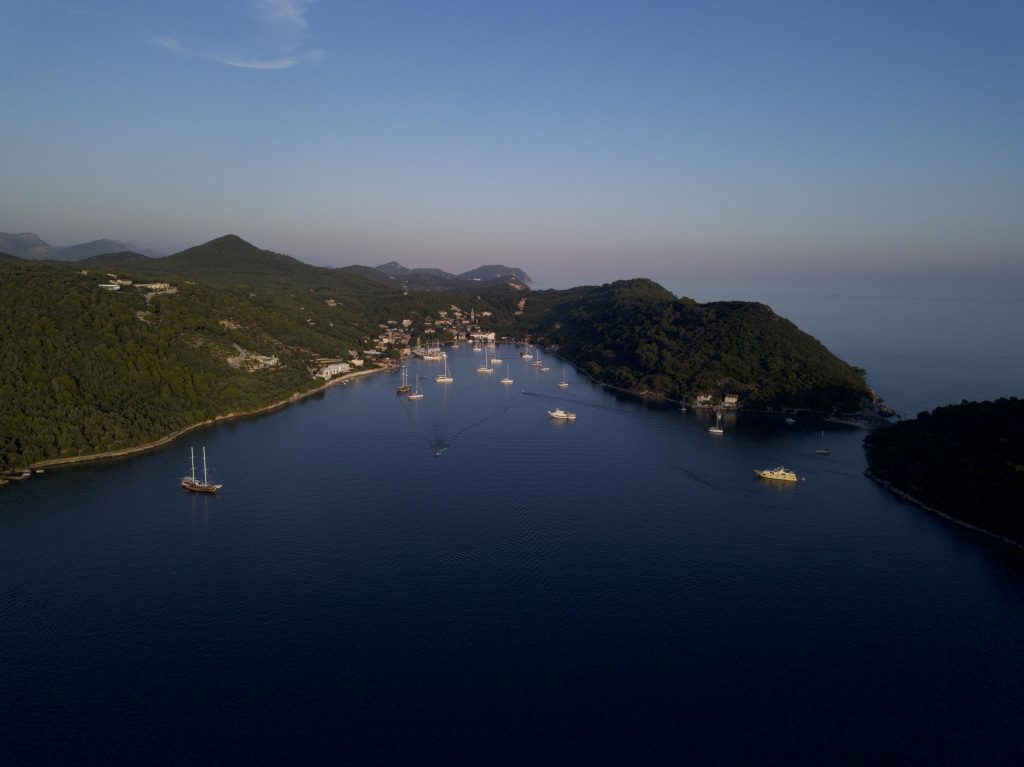
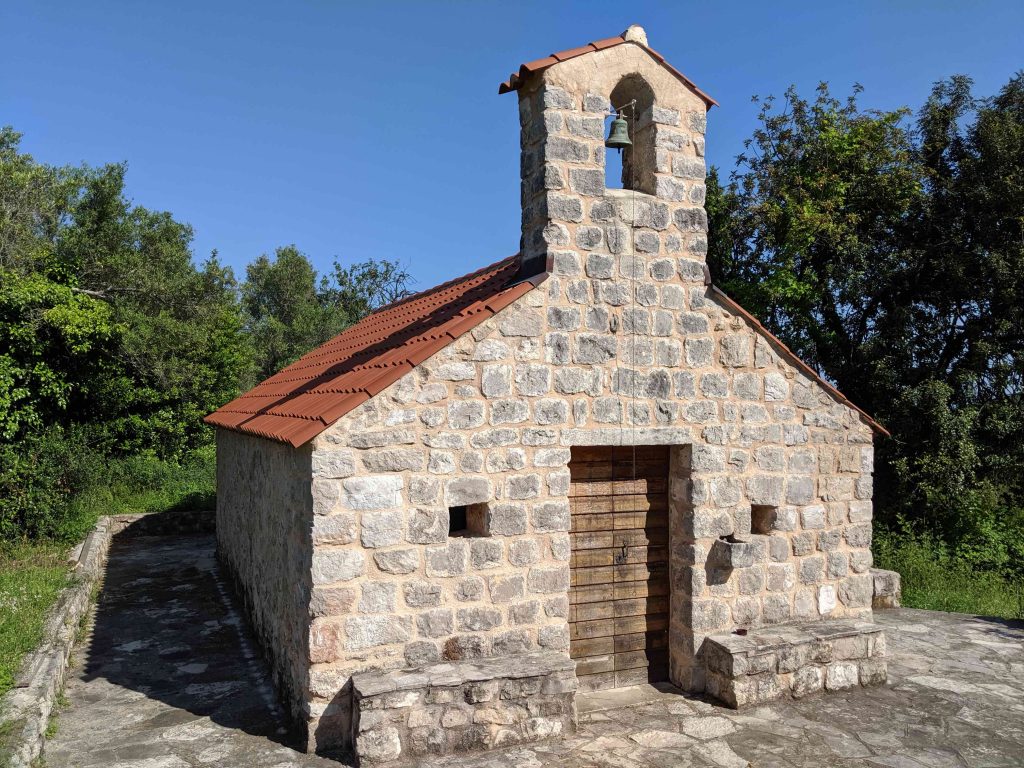
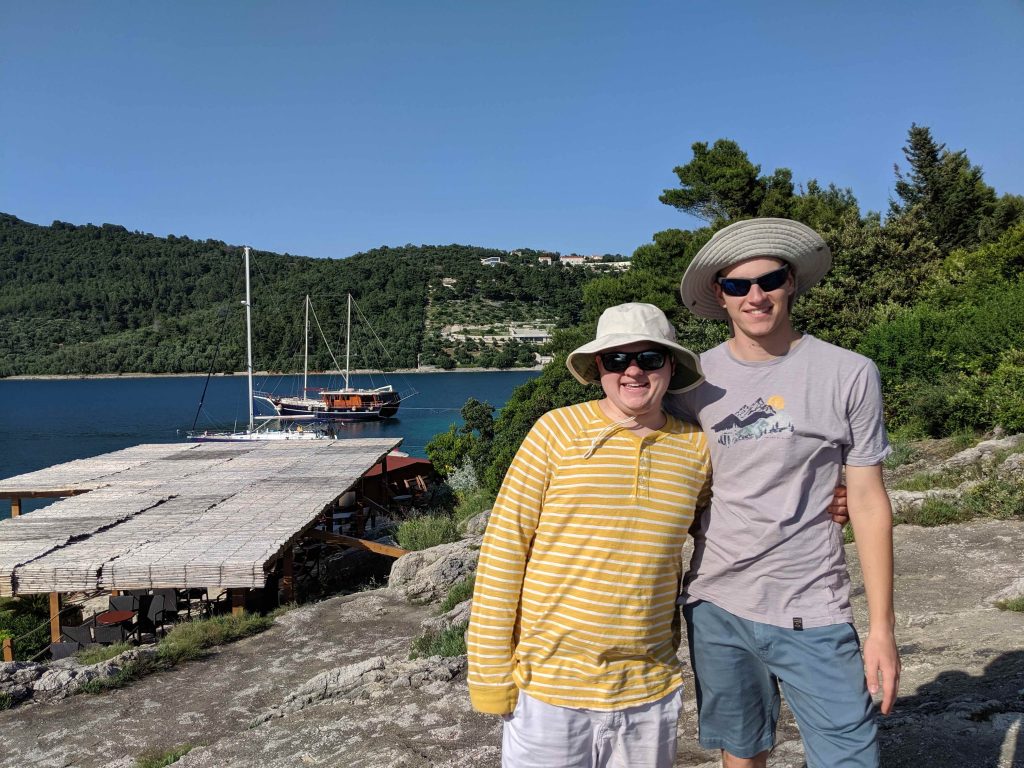
The morning brought a fresh breeze, and we wound our way between tiny islets and out into the Mljet Channel, an expansive body of water separating the mainland from the long skinny island of Mljet. This island had featured prominently in my research over the previous winter, due in part to the northwestern end of the island being established as a National Park, and little development elsewhere on the island. A bigger picture started to emerge, as we learned about Croatia’s admirable efforts to manage a total of eight National Parks. For such a small country, and a relatively young one at that, they got our attention quickly with their concern for the environment and saving their national treasures for future generations.
We set our goal for the day to be Polace, on the northern tip of Mljet and the entry point to the Mljet National Park. Sailing down the channel with a following breeze gave Todd’s son Peter a chance to learn how to steer a boat through jibes and wind shifts, while all the time keeping a watchful eye out for the many high-speed ferries running the coastline here. This includes the speed champion of the entire fleet, the Krilo Eclipse, clocking in at 33 knots. Let’s hope that captain’s credentials are commiserate with the horsepower he or she has at their fingertips!
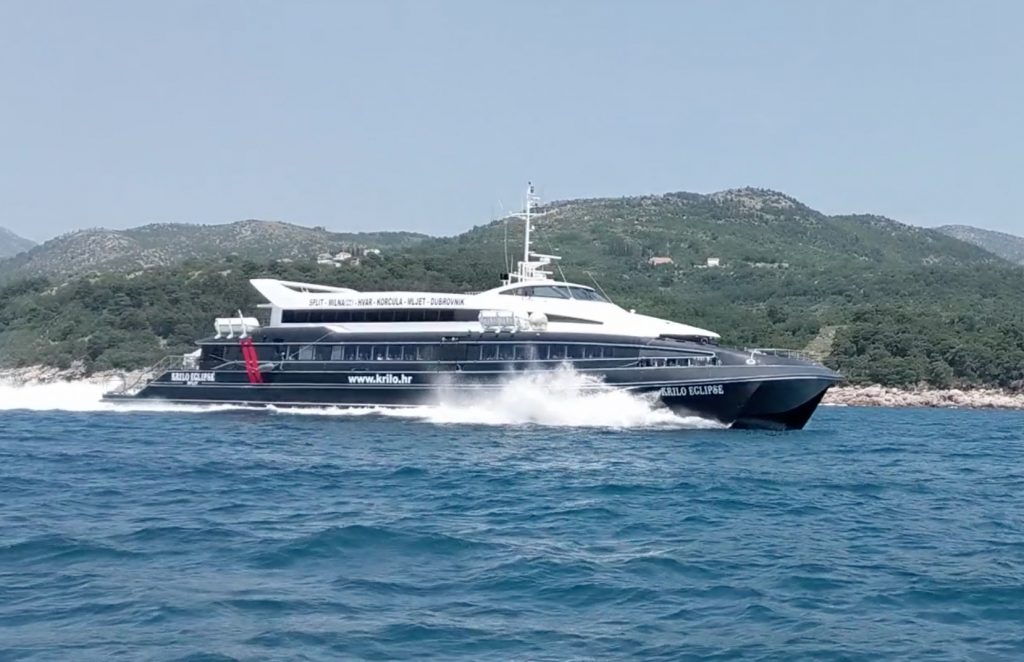
Our favorable wind carried us gently down the channel until it had had enough for the day, and we clicked the motor on for the last few minutes as we followed twisting channels of water leading into the harbor. Polace had possibly the best weather protection you could expect in the Adriatic, set deep into the island with high bluffs circling the entire, perfectly round, anchorage. While this protection was tempting, there was no adverse weather in the forecast, and we chose instead to drop our anchor in a nice shallow notch in the shore a mile away with a small rocky reef protecting it perfectly from the waves entering from the boat traffic in the Mljet Channel. We were beginning to realize that anchoring in Croatia has its challenges unlike other Med destinations, namely due to too much rock, too little sand, and too deep of depths in general. But this little notch had a bit of Caribbean-esque turquoise blue water showing through to an ideal sandy bottom. Our own Croatian Jost Van Dyke experience awaited us.
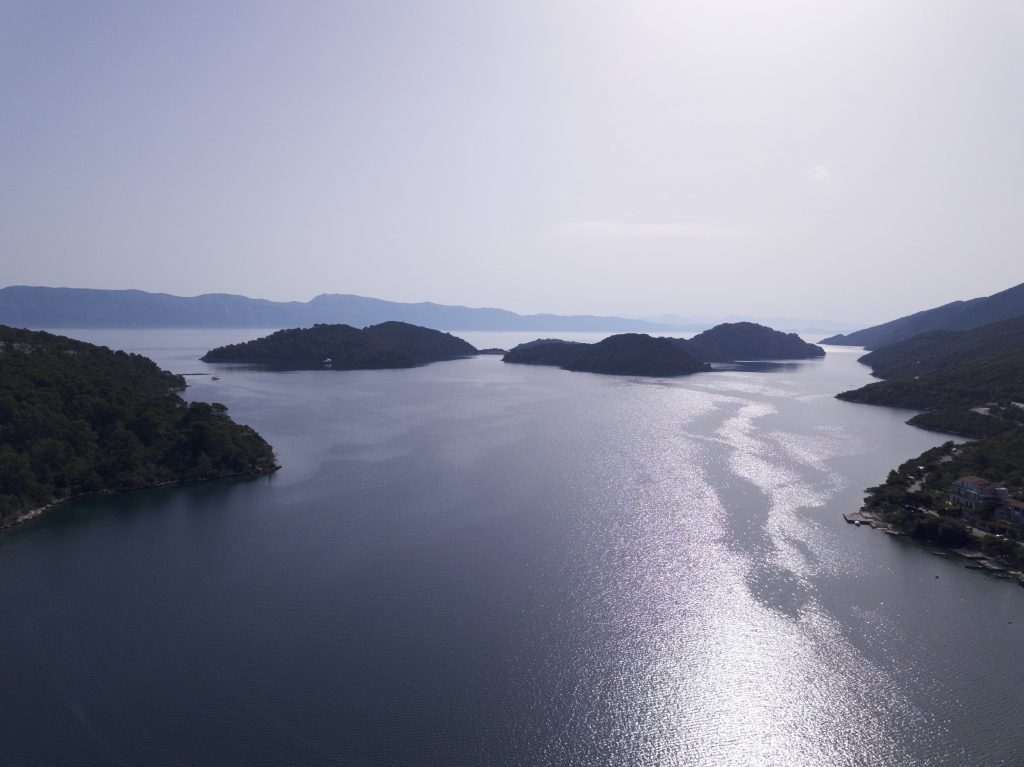

We had barely collected the beauty of this spot in our minds, when, in Croatian style, another sailboat shimmied their way past us and dropped their anchor between us and the reef. A palpable silence fall upon our crew. It was like the feeling you have when you are first in line for the chair lift and some other group sweeps casually past you. Did we just get skunked? Alas, there was sufficient room for two boats, and we tried to be good neighbors and share our little slice of heaven. Soon the paddleboards and snorkeling gear were assembled and an exploration of our new digs was launched. Richard and I found several large piles of bagged garbage, the remnants of what appeared to have been a beach cleanup effort that ended a little too soon. We nuzzled the dinghy into the shallows and began loading it up with bags whose plastic material was suffering from too much time in the sun and ready to burst. Who knew how many seasons this pile had sat here. A few more months in the elements and this collection of garbage would be scattered back over the shoreline again. With just the two of us, Richard and I were able to bring the dinghy up on a plane, giving us a fast transit to the town where we scoped out the local dumpster and began what soon was the first of three trips ashore. It felt good to do some community service, but confusing why someone would leave such a project partway done.
The next morning, we quickly agreed that this spot was so beautiful and there was so much to see ashore at the Mljet National Park, that we should stay anchored here for two nights. We headed ashore in the dinghy to get started on our park adventure. Buying tickets at the kiosk in the shadow of a Roman palace ruins set the stage.
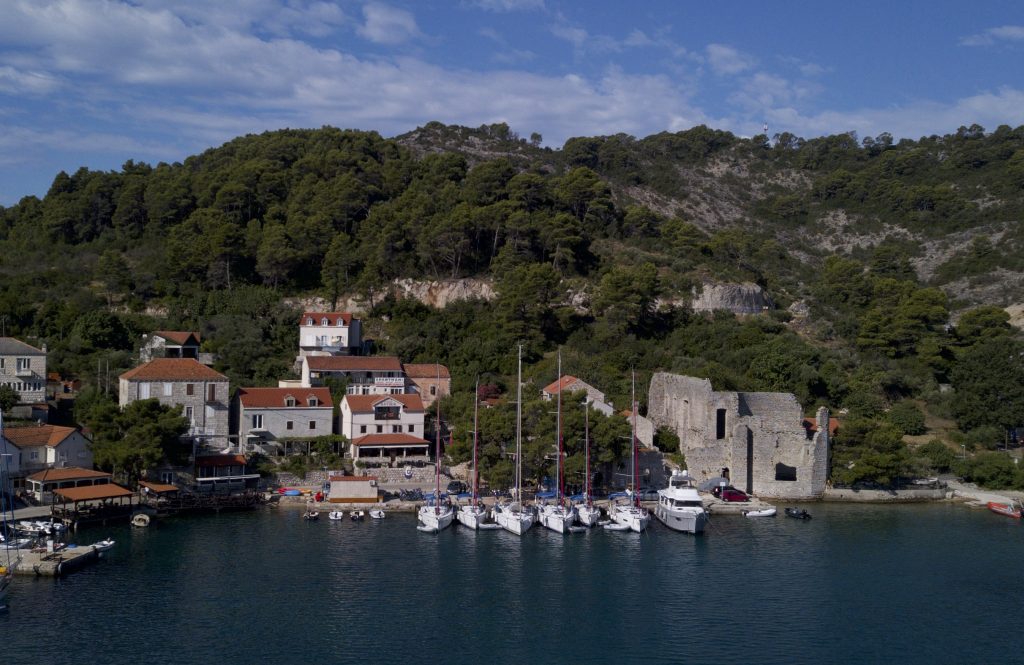
We opted for a hike on one of the many very well maintained trails through the park, taking us to a local summit with a fire tower and wide-angle views of the entire Mljet and adjacent Korcula islands.

Below us was one of the top hiking destinations in this park, the lake Veiko Jezero. Even though we spend every day on the water, it’s hard not to deny the pull of another watery destination. We made quick time on the path down from the summit, passing several mountain bike trails, and the typical clusters of European tourists at the lake’s edge wading in the water with an accidental lack of clothing. Now it was becoming clear why I was having trouble finding a new pair of swim trunks for sale!
With no time to doddle, we sought out the ferry landing for a boat that runs across the lake to St Mary’s Island where a 11th century Benedictine monastery resided. With the peace and quiet we felt on this summer day, I can only imagine the attraction these monks felt to this spot on the lake so many centuries ago. We joined many others in taking a refreshing dip in the water off the island – a little chilly like a high mountain lake at first, but it sure hit the spot.
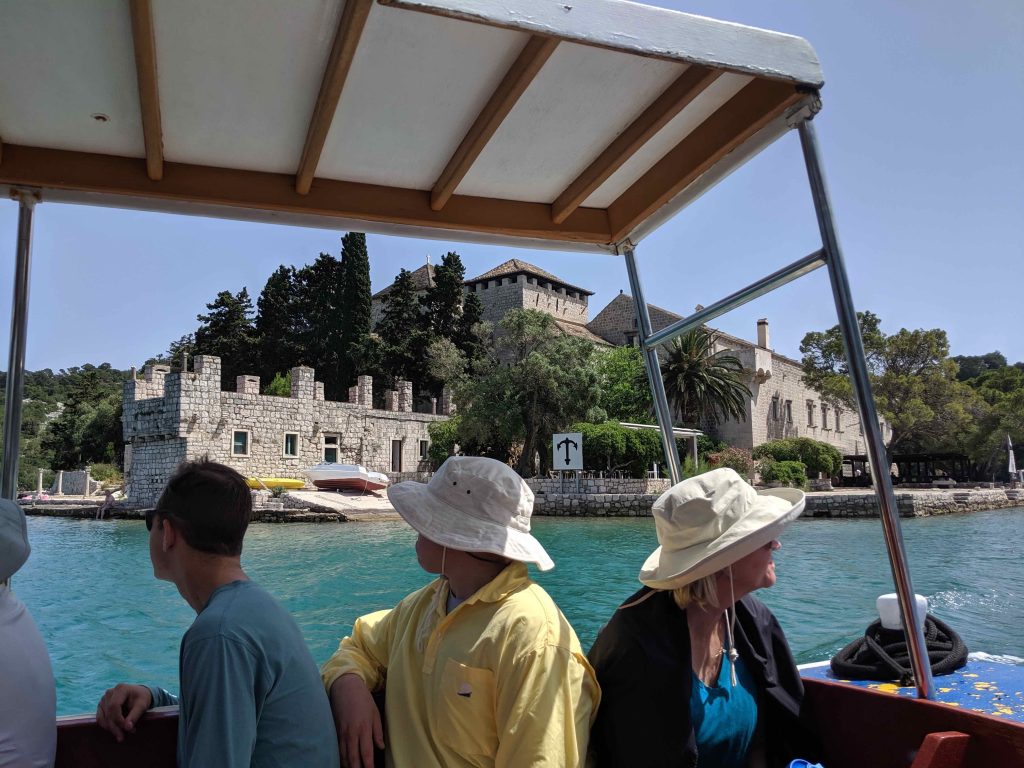
Back in the town of Polace, we checked out a spot for dinner, and in the process it started to become clear how things worked in these popular Croatian anchorages. If you anchored out, as we had done, you are charged a pretty stiff daily fee by the national park. This was supposedly for the privilege of using the park area, but was an action that was very unusual in most sailing destinations. Typically, if you use your own anchor, the assumption is that you’ve paid for the equipment and you are making your own decision on where to drop it and taking your own responsibility for being safe. But here, anchoring your own boat costs money. We were accustomed to only paying when you picked up a mooring ball or tied to a dock. Paying to anchor would have made since if it included admission to the park, but we had paid for a separate daily entrance fee already today. Soon we learned that if you choose to come into one of the many docks run by the shoreside restaurants, the park police will look the other way when making their collection rounds. The cost to anchor is high enough that it makes dinner a bargain, perhaps even free if you’re just a couple. If we ever came back here, we’d use one of the restaurant docks. Yet another lesson learned for this second in the birth order captain!
After cleaning up at the boat we headed back into the town for dinner. The restaurant we chose – Stella Maris – had a chipper young waiter eager to walk us through the dinner specials. The most popular dish and one that seemed to be a specialty of this part of Croatia was based on the ‘under-the-belle’ technique. It was a little hard to understand until he actually showed us in the kitchen, but it entails the use of a iron dome over the selected meat or seafood, surrounded by fresh vegetables, all sitting on top of a thick slab of stone, heated by a wood fire, and slow cooked for 3 or more hours. To lock in the flavor and moisture, they pack wood ash around the edge of the bell to maintain an air-tight seal. Karen and I had chosen the veal under-the-belle, which came with potatoes and carrots that had been simmering in the juices of the veal all afternoon. It’s possible we could have tried to emulate this dish at home with a claypot, but this meat fell effortlessly off the bone and the taste was out of this world. The misspelling and double meaning of ‘belle’ in the name was not lost on us. The gears started turning with Karen and I on how we could make a return trip here in the ensuing weeks.

In the morning, after a trip up the mast for an inspection of the rigging and a repair to the code 0 halyard, we raised anchor and headed back out to the Mljet Channel and north to the island of Korcula. The winds were light and on the bow, forcing us to take a few tacks before it shifted and built, giving us a nice single tack run into the harbor of Lambruda on the southeast corner. Navigating past several low rocky islands with mounds of shallow pointy rocks near the surface reminded me of the need for attentive sailing in our home waters of Maine. We tied up at a marina in Lambruda, selected in part to meet our need for more fresh water in our tanks. The convenience of stepping directing on shore was sure nice too.
The switch to summer continued to be in full swing, as we sought out shade from the relentless heat. A short walk down the shore of this sleepy summer hamlet was a true sandy beach, a real rarity in Croatia. We had walked or anchored near many spots labelled as a ‘beach’, only to find out they were a pile of stones. Here, you could wiggle your toes into wet sand at the water’s edge, or lay your towel out for a short snooze without feeling like you had chosen the austerity of a local gravel pit.
The old town of Korcula, for which the island had been named, was a short taxi ride away, and we headed to town in the late afternoon once the heat broke, not sure what to expect other than many accolades from the cruising guide. And they were accurate. This was a smaller version of the walled city of Dubrovnik, without the incessant crowds (or ATMs). We chose to climb the stairs to the top of St Marks Church where you can squeeze out on to a narrow balcony surrounding the belfry, with authentic looking gargoyles. The refreshing breeze at this height felt like ice cream running through your veins. As the sun was getting low in the sky, I was once again reminded why so many locals choose a siesta in this climate. We had braved the afternoon heat earlier in the day, feeling like stranded explorers in the Sahara Desert hallucinating about a mirage of water, when we could have gotten a few hours of rest and started on Part 2 of the day at this time feeling energetic and cheery.
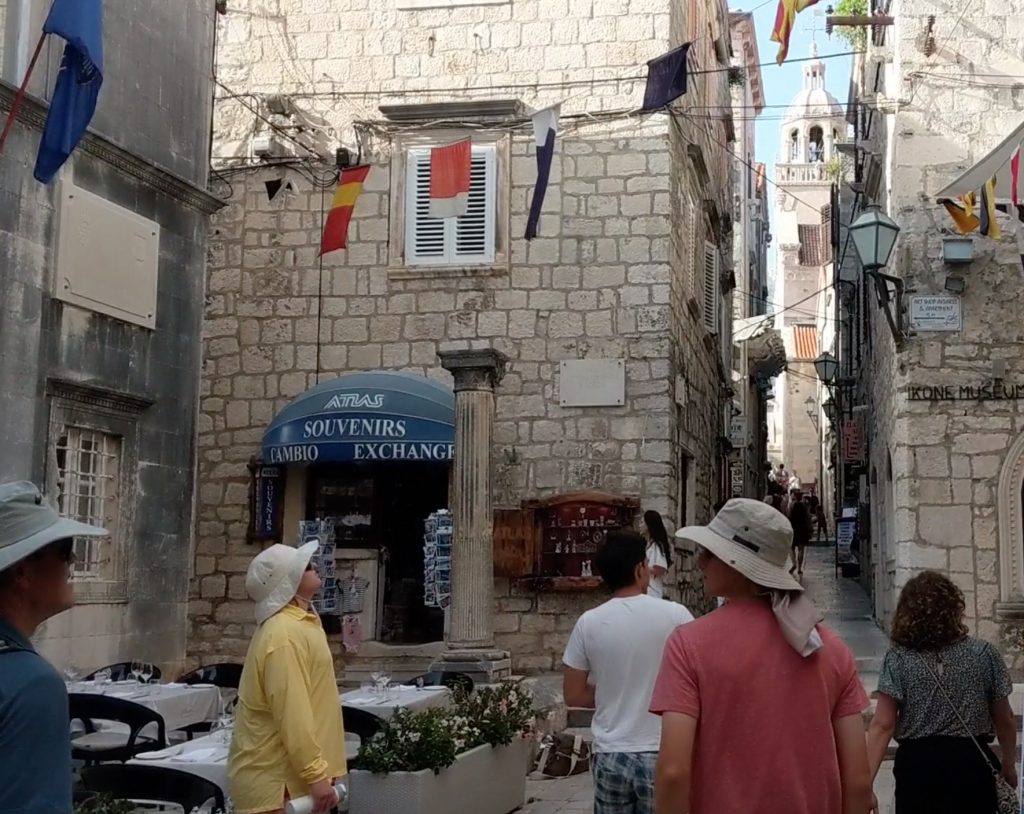
Down every alley in Korcula, small cafes spilled out onto the sidewalk, tempting us to linger to read menus. Our persistence for the perfect dinner venue paid off as we discovered a wide esplanade with restaurants occupying every square meter of the water’s edge. These were typical summer cafes who set up their outdoor tables and umbrellas overlooking the water, with a crowded pedestrian walkway between the tables and the old stone buildings housing their kitchens. In this climate, no one would bother to eat inside, and regardless, it didn’t appear that they had any room for tables indoors, with just a single door opening into a kitchen area no larger than a one car garage. Apparently, good space utilization was a necessary skill in this business. Although none of these restaurants were serving ‘under-the-belle’ specialities, we walked away with happy tummies and tired feet.
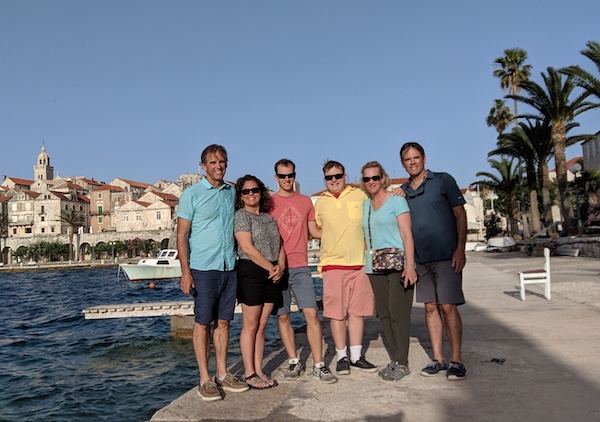
In the morning, I chose a short run through the interior countryside, finding several rolling vineyards and newly constructed farm houses. It seemed that the island was discovering the economic potential of locally produced wines. After we all took advantage of the shore-side warm showers, and gave Sea Rose a bath as well, we dropped our dock lines and turned south. Korcula would mark the northernmost point with Todd and family. The winds were non-existent and we motored back down along the eastern shore of Mljet. Oddly, we saw a considerable about of plastic garbage on the water, including some large chunks of styrofoam, commonly used by local fishing boats to pack and preserve their fresh catch. Had this garbage problem been there all along, but not as obvious when we were sailing in strong winds?
We motored into the tiny harbor of Okuklje on the south end of Mljet. The footprint of the town consisted of a collection of buildings exclusively at the water’s edge and most of those structures were restaurants. Now that we were aware of the drill, we knew to expect wait staff to be down on their docks waving at us as we approached the harbor to come dock and dine with them. But with the last two dinners out, we chose to anchor instead, running a stern line ashore and tying off to a large tree. The restaurant staff were so earnest, holding up a dock line as a welcoming temptation, that it was hard to make eye contact. There appeared to be no easy way to get to these restaurants by car; they were 100% dependent on arriving sailboats. Thankfully, as we settled into our anchorage spot, we watched a steady stream of chartered sailboats motoring into the cove and heading to the restaurant docks. Phew, they were going to do just fine without our patronage! The multiple shades of blue and turquoise waters reminded me of the beautiful refracted light of the ice caves in Iceland, but with the important benefit of being much warmer!
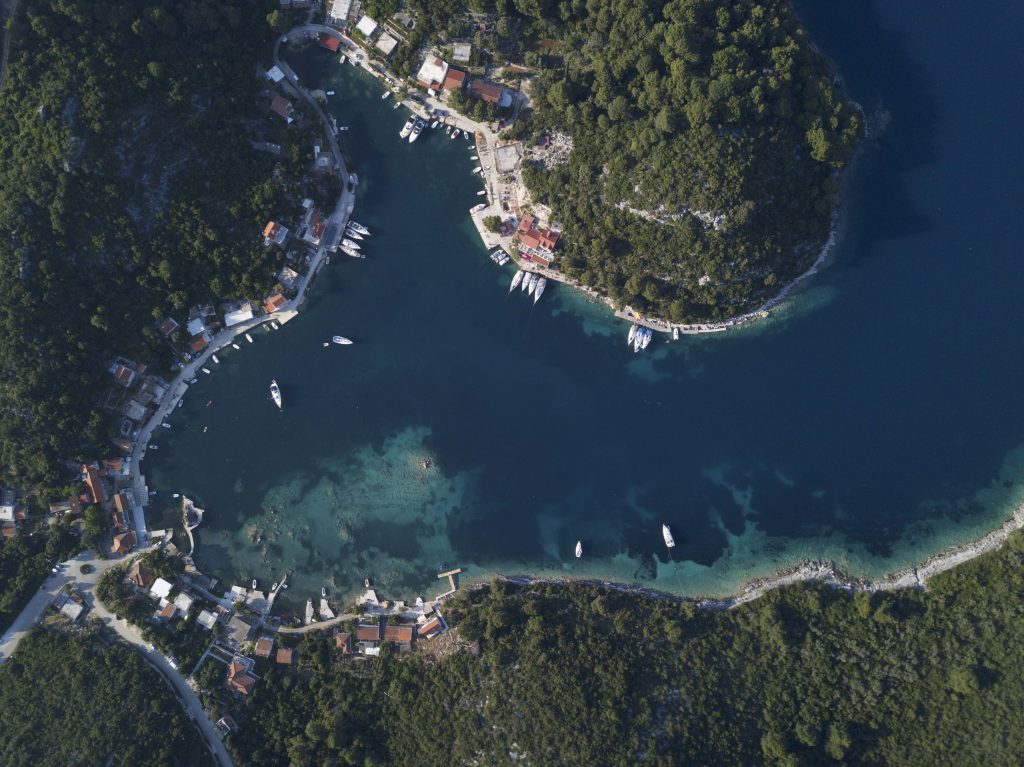
With glassy calm conditions in the morning, I took an early paddle board trip out of the harbor into the Mjlet channel, finding that even when there is no wind, tiny swells from distant origins can still throw you off balance! We were underway on Sea Rose not long after, resolving to motor the 20 miles back to Cavtat, taking a close drive by the waterfront of Dubrovnik to droll one more time at the sights of the Old Town and to take more pictures. It was comfortable arriving back in familiar Cavtat. The sun was filling the sky, and many more large yachts had taken up temporary residence at the dock. We didn’t even consider the sky high rates of the dock, opting instead for the economical (aka free) option of anchoring. But Cavtat has the issue of a very deep harbor. If you were to set out the proper amount of scope, one boat might take up the whole anchorage. Around the perimeter, very close to the shore where the depths became more manageable, the area was taken up by local mooring buoys, the conundrum of modern day cruising. Upon closer examination, we found a wide enough opening between moorings that we could anchor and run a stern anchor out to the beach. The weather forecast was mild, and we felt like this was a good compromise.

In addition to challenging anchoring, the Cavtat harbor has the potentially annoying trait of being directly below the landing path for flights into the airport. Surprising, perhaps for the beautiful surroundings, this did not detract from the experience. In fact, Todd’s son Richard, with his avid interest in aviation, regaled us with his knowledge of aircraft models and routes as they flew close overhead. Curiously, many locals and a collection of tourists were swimming off the beach, and meandering through the moored boats. It seemed like a risky adventure to me, but I had to remind myself that this was in the ‘take your own risk, live with the consequences, we don’t sue each other’ European style of living. Soon enough, we were all in the water, playing a game of makeshift water polo. When in Cavtat, do as the Cavtats do.
Todd’s family was leaving the next day and as a good brother does, he took us all out to dinner to celebrate a great week of sight seeing, and oh by the way, an upcoming birthday for yours truly.
Back on the boat, a nightcap of limoncello and a selection of onboard tunes had a hard time competing with the many bars onshore, so we all turned in for the night, reveling in how equally beautiful this harbor can be at night.
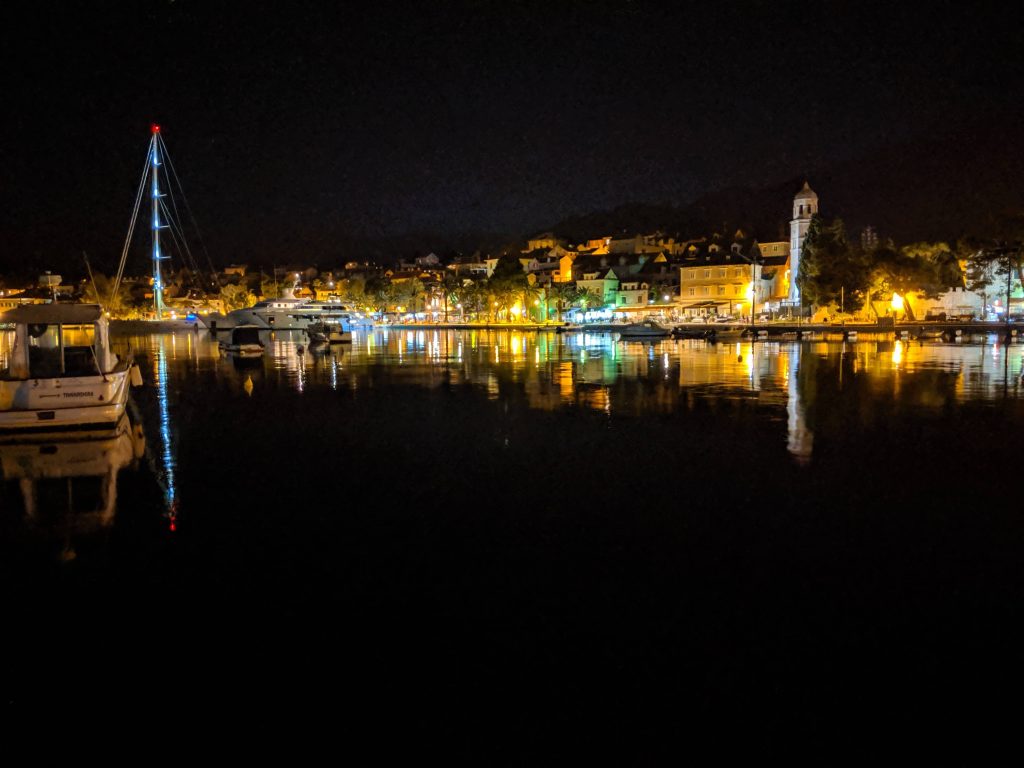
We bid adieu to Todd, Molly, Richard and Peter in the morning, feeling like we gave their family a fun filled week of adventure, while giving Karen and I a teaser on what special sights were in our near future in Croatia. If this first week was any indication, we had better stock up on more SD cards for our cameras! In the meantime, thanks Todd for letting me play ‘first into the harbor’, but you can now (please) take back your birth order post!

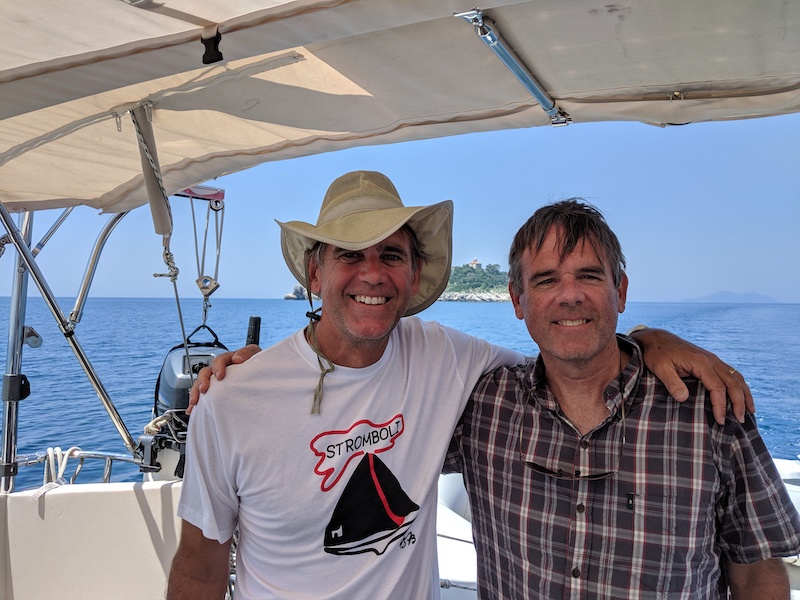
Love your story and photos, Tom! The Caveat at night photo is stunning. Hope to see you and Karen soon!
Thanks Patty, hope to see you soon too!